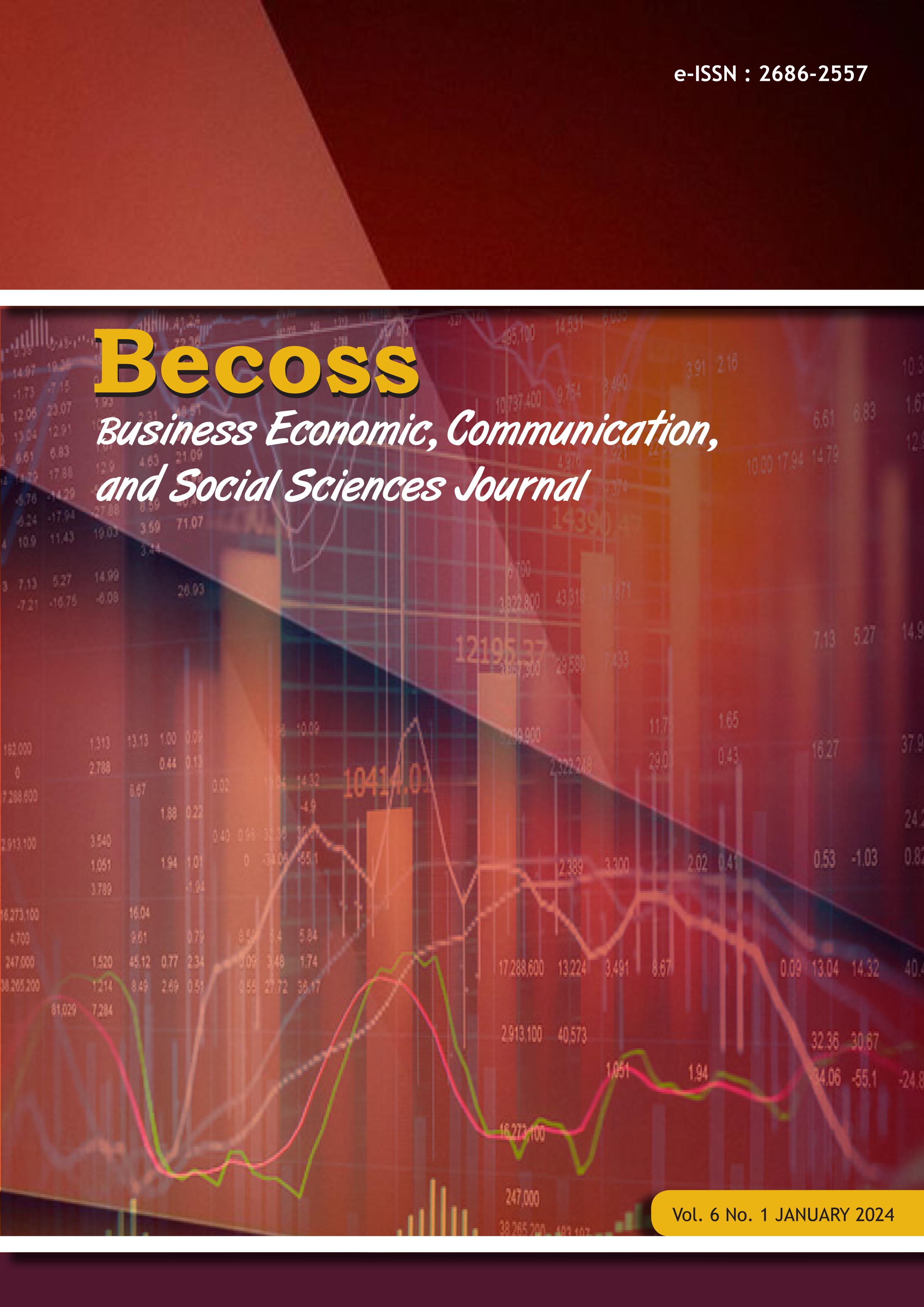The Effectiveness of Food Vlogger Review on Purchase Intention Toward Food Product (Study on Mega Influencer)
DOI:
https://doi.org/10.21512/becossjournal.v6i1.10483Keywords:
Youtube, Food Vloggers, Food Product, Customer Attitude, Purchase IntentionAbstract
Objectives: The objective of this research is to investigate the factors, such as source credibility (attractiveness, trustworthiness, and competence) and brand-influence match up congruence, that might contribute to better customer attitudes and buy intentions. The study is focused on millennials and Gen Z between the ages of 18 and 34 who have recently seen food vloggers review products on Youtube.
Method: This research utilizes using an online questionnaire that is made with Google Form distributed to 265 respondents. The full-scale data is analyzed through SmartPLS and bootstrapping analysis to test for reliability, validity, and the research’s hypotheses to identify the relationship between variables.
Results: The findings of the research shows that trustworthiness, expertise, similarity, liking, and familiarity value has a positive and significant relationship with customer attitude toward food product. Customer attitude toward food product also has a positive and significant relationship with purchase intention. Then both Attractiveness and Brand-Influencer Match-up does not have a positive influence significant effect on customer attitude toward food product.
Conclusion: The results of this research, it can be concluded there are 6 variables that measure food vlogger reviews that are included in the source credibility model, namely trustworthiness, attractiveness, expertise, liking, familiarity, and similarity. The more trustworthiness, expertise, similarity, liking, familiarity felt by food vloggers by customers, the more positive customer attitudes towards food products will be.
Key words:
Youtube, Food vloggers, Food Product, Customer Attitude, Purchase Intention
References
Aaker, A. David. 2013. Manajemen Ekuitas Merek. Alih Bahasa: Aris Ananda, (2013), Spektrum Mitra Utama, Jakarta.
Chen, N., & Yang, Y. (2021). How Customer Experience Affects Consumer Purchase Intention in Live Streaming E-commerce: The Role of Live Streamers. Retrieved from https://papers.ssrn.com/sol3/papers.cfm?abstract_id=4050207
Cherry, K. (2018). Cross-Sectional Research Method: How Does It Work? Advantages and Challenges.https://www.scirp.org/(S(czeh2tfqw2orz553k1w0r45))/reference/referencespapers.aspx?referenceid=2889851
Datareportal. (2022). Digital 2022 Indonesia. https://datareportal.com/reports/digital-2022-indonesia
De Veirman, M., Cauberghe, V., & Hudders, L. (2017). Marketing through Instagram influencers: The impact of number of followers and product divergence on brand attitude. International Journal of Advertising, 36(5), 798–828. https://doi.org/10.1080/02650487.2017.1348035
Djafarova, E., & Rushworth, C. (2017). Exploring the credibility of online celebrities’ Instagram profiles in influencing the purchase decisions of young female users. Computers in Human Behavior, 68, 1–7. https://doi.org/10.1016/j.chb.2016.11.009
Garcia, P.N., Saura, I.R., Orejula, A.R., & Junior, J.R. (2020). Purchase intention and purchase behavior online: A cross-cultural approach. Heliyon, 6(6). Retrieved from https://www.sciencedirect.com/science/article/pii/S2405844020311282#fig2
Ha, N. M., & Lam, N. H. (2016). The Effects of Celebrity Endorsement on Customer’s Attitude toward Brand and Purchase Intention. International Journal of Economics and Finance, 9(1), 64. doi:10.5539/ijef.v9n1p64
Hair, J.F., Hult, G.T.M, Ringle, C.M., & Sarstedt, M. (2017). A primer on partial least squares structural equation modeling (PLS-SEM). Thousand Oaks, CA: Sage Publications
Huber, F., Herrmann, A., Meyer, F., Vogel, J., & Wollhardt, K.Kausalmodellierung. (2007). Partial Least Squares–Eine anwendungsorientierte Einführung. Gabler, Wiesbaden.
Hughes, C., Swaminathan, V., & Brooks, G. (2019). Driving brand engagement through online social influencers: An empirical investigation of sponsored blogging campaigns. Journal of Marketing, 83(5), 78–96. https://doi.org/10.1177/0022242919854374
Kotler P. & Armstrong G. (2010), Principles of Marketing, New Jersey: Pearson Prentice Hall.
Malhotra, Narakesh K. (2010). Marketing Research: An Applied Orientation Sixth Edition. New Jersey: Pearson.
Mccombes, S. (2022). Sampling Method | Types and Techniques Explained. Retrieved from https://www.scribbr.com/methodology/sampling-methods/
McLeod, S. (2019). Likert Scale Definition, Examples and Analysis. Retrieved from https://www.simplypsychology.org/likert-scale.html
Sánchez-Fernández, R., & Jiménez-Castillo, D. (2021). How social media influencers affect behavioral intentions towards recommended brands: the role of emotional attachment and information value. Journal of Marketing Management, 37(11-12), 1123–1147. doi:10.1080/0267257x.2020.1866648
Schouten, A. P., Janssen, L., & Verspaget, M. (2019). Celebrity vs. Influencer endorsements in advertising: The role of identification, credibility, and Product-Endorser fit. International Journal of Advertising, 39(2), 258–281. https://doi.org/10.1080/02650487.2019.1634898
Shah, S. S. H., Aziz, J., Jaffari, A. R., Waris, S., Ejaz, W., Fatima, M., & Sherazi, S. K. (2012). The impact of brands on consumer purchase intentions. Asian Journal of Business Management, 4(2), 105-110
Singh, K. (2021). Influencer Marketing from a Consumer Perspective: How Attitude, Trust, and Word of Mouth Affect Buying Behavior. European Integration Studies. Retrieved from https://eis.ktu.lt/index.php/EIS/article/view/28803
Statista. (2019). Social media in Indonesia – statistics & facts. https://www.statista.com/topics/8306/social-media-in-indonesia/#topicOverview
Sugiyono. (2014). Metode Penelitian Pendidikan Pendekatan Kuantitatif, Kualitatif, dan R&D. Bandung: Alfabeta.
Downloads
Published
How to Cite
Issue
Section
License
Copyright (c) 2024 Business Economic, Communication, and Social Sciences Journal (BECOSS)

This work is licensed under a Creative Commons Attribution-ShareAlike 4.0 International License.
Authors who publish with this journal agree to the following terms:
- Authors retain copyright and grant the journal right of first publication with the work simultaneously licensed under a Creative Commons Attribution License - Share Alike that allows others to share the work with an acknowledgment of the work's authorship and initial publication in this journal.
- Authors are able to enter into separate, additional contractual arrangements for the non-exclusive distribution of the journal's published version of the work (e.g., post it to an institutional repository or publish it in a book), with an acknowledgment of its initial publication in this journal.
- Authors are permitted and encouraged to post their work online (e.g., in institutional repositories or on their website) prior to and during the submission process, as it can lead to productive exchanges, as well as earlier and greater citation of published work.
USER RIGHTS
All articles published Open Access will be immediately and permanently free for everyone to read and download. We are continuously working with our author communities to select the best choice of license options, currently being defined for this journal as follows: Creative Commons Attribution-Share Alike (CC BY-SA)






